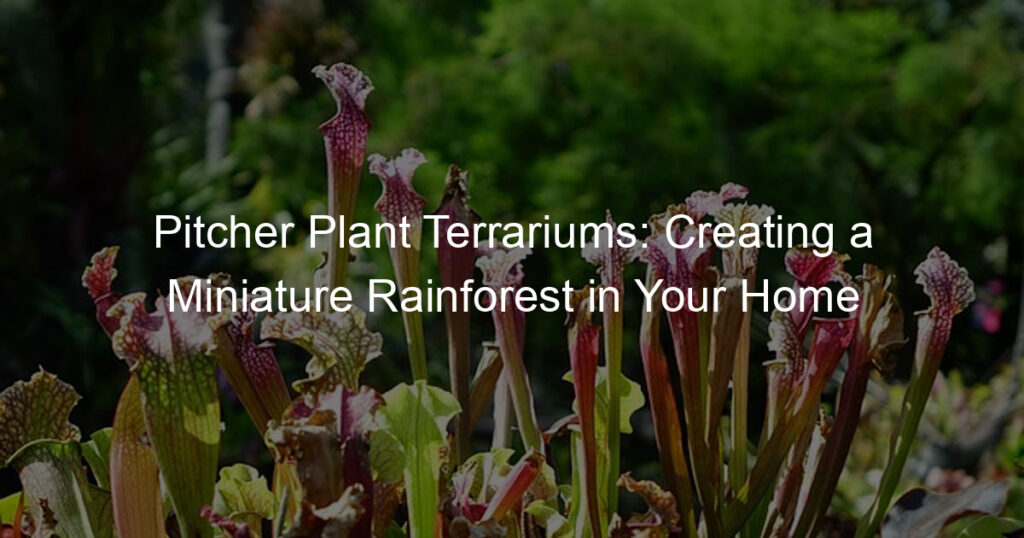Have you ever wanted to create a whimsical and unique piece of decor in your home? A pitcher plant terrarium can help you do just that! Whether you’re an experienced gardener looking for something new to try or are simply wanting to bring some of nature’s beauty into your space with minimal effort, this is the perfect project for you. Pitcher plants are one-of-a-kind and make amazing decorative pieces when placed in a terrarium — almost like creating a mini rainforest right at home.
What is a pitcher plant terrarium?
A pitcher plant terrarium is an incredible way to bring a piece of the outdoors inside. It’s a miniature ecosystem that not only looks impressive but can also educate people about the wonders of nature.
These enclosed habitats feature colorful and distinctive pitcher plants as well as other flora adapted for life in damp, shady environments. Some are even outfitted with specialized lighting and automated misting systems to make sure the environment closely mirrors its natural habitat!
Not only is it fun to watch the pitcher plants grow and thrive – you can even have your mini-zoo by including minute frogs, insects, and other small organisms! If you’re looking for an interesting conversation starter or a unique touch to any space, consider creating your pitcher plant terrarium!
How do you make a pitcher plant terrarium?
Making a pitcher plant terrarium is an easy and fun way to bring a bit of nature into your home. All that’s needed are the ingredients to create a mixture of equal parts soil and sphagnum moss, as well as a few carnivorous pitcher plants.
A potting tray is necessary, with enough drainage holes in the bottom for any excess water to drain out. Once your ingredients are prepped, you can start layering them in your potting tray – mix your soil and sphagnum moss completely together at the bottom, then add enough soil to give your pitcher plants some cushioning before planting them into their terrarium home.
Finally, cover the surface of the soil with some decorative colored gravel for a vibrant contrast and an eye-catching display. Before you know it, you’ll have a unique terrarium that’s sure to draw plenty of attention: all thanks to those beautiful carnivorous pitcher plants!
What plants can be used in a terrarium with pitcher plants?
Creating a terrarium with pitcher plants can be fun, challenging, and rewarding. To complement the pitcher plants in your terrarium, try adding ferns, begonias, or mosses. These plants thrive in moist and humid environments similar to that seen in a closed terrarium.
For example, the Juniper tree is an upright plant with great foliage that works well as a backdrop for your pitcher plants and other smaller plants. Additionally, ivy can provide a trailing effect over the sides of the terrarium.
Make sure to keep an eye on the amount of water that can build up quickly – if needed you can add small holes for drainage to ensure proper airflow and evaporation of excess moisture.
How much light do pitcher plants need in a terrarium?
Pitcher plants are an amazing part of terrariums! They love humid and wet environments so keeping them in a terrarium is perfect for them. In terms of light, they need bright indirect light or partial shade.
This means you can place them in front of a south-facing window – the perfect sunny spot – with a curtain, or aluminum foil to filter out the light or provide added protection against the sun.
If your pitcher plant is not under enough light, the leaves will turn yellow and it may stop producing pitchers, so you’ll want to make sure they get just the right amount to keep that vibrant green and summery look going all year round!
How often do you water pitcher plants in a terrarium?
Taking care of pitcher plants in a terrarium is relatively easy, but timing the watering just right takes some practice. Most species should be watered about once a week, though levels can vary depending on humidity and temperature levels.
Of course, if these plants are outside enjoying natural conditions, that schedule can change significantly. It’s recommended to check the soil first before adding water and only when that soil is slightly dry; replace any excess water that pools in the tray or planter beneath it. With a little attention to their hydration needs, pitcher plants can thrive for years in any terrarium.
What are common problems with pitcher plant terrariums?
Pitcher plant terrariums are beautiful, exotic centers for any home, but like any type of garden, proper upkeep is key. One of the most common problems is unsaturated soil–without more water than other plants prefer, the pitcher plants’ bald spots will fill in and die off.
Additionally, it’s important to note that pitcher plants need a lot of nitrogen and other nutrients from their soil to survive; without those additives, they can struggle or even die over time. Finally, they don’t mix well with hardy houseplants that are meant to be resilient in low light or humid environments–making it difficult to keep them both in the same terrarium.
All in all, you have to pay very close attention to the needs of your pitcher plant before you create your terrarium otherwise you’ll find yourself dealing with unhappy plants and frustrated gardeners!
Conclusion
All in all, creating a pitcher plant terrarium offers a diverse range of benefits that can help to give your home an inviting touch while also making it more lively. Not only are they visually appealing, but they are also a great way to educate yourself and others about the rainforest’s many inhabitants. Since these terrariums require minimal maintenance on your part, you can be sure that your biologically rich ecosystem will remain intact for years to come.








